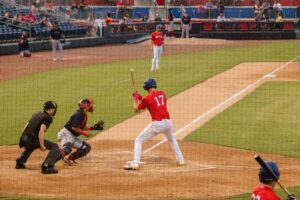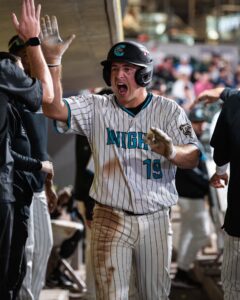Fool Me Once: Good seasons by OK prospects, part 1
When I was a young girl, my father took me into the city to see a White Sox game. He said “Owens, when you’re called up, would you be the savior of the broken, the beaten and the damned?”
As it turns out, Jerry Owens was not the savior of anything, not that the Sox needed one in 2005. That was right around the time I was getting into baseball (and emo bands) as an eighth-grader, and as a new fan I had a somewhat naive and optimistic view of the minor leagues. If someone had a good season in the minors, regardless of what level or age or how many years of experience, that meant they were good and should be brought up.
In the intervening years, I’ve naturally modified this view, but in tribute to my starry-eyed younger self, here is a list of The Most Exciting Player From Each Year Since I’ve Been A Fan That I Thought Was Good That Turned Out To Not Actually Be As Good As I Thought They Were (alternate title), for 2005 through 2010. Part 2 to cover 2011 to present will come next week.
2005 — Brian Anderson

It’s true that Jerry Owens had a great season with Birmingham in 2005 (173 hits in 130 games, 38 stolen bases), but Brian Anderson was my dude. He had glorious blonde hair and he could play center field like nobody’s business. Anderson was drafted 15th overall in the 2003 (ahead of such future Sox as David Aardsma and Carlos Quentin), and was carrying a strong performance in his first two seasons into 2005. That year, he slashed .294/.358/.470 and looked ready to take over big-league center field duties from the recently traded Aaron Rowand.
But, he wasn’t. The bat never translated from the minors to the majors. Instead of Anderson dashing around center making incredible defensive plays, Rob Mackowiak got the bulk of playing time there. The Sox kept Anderson around a while to try to figure it out. Then they traded him away in 2009 for Boston’s Mark Kotsay, and in 2010, he transitioned to being a pitcher. This move also didn’t pan out, although it did briefly reunite him with the Sox in 2015 before his final release.
2006 — Heath Phillips

It’s funny, because in my memory Heath Phillips was absolutely untouchable in 2006 for the Knights, but looking back, he was merely very good. It’s possible that my inexperienced eyes were taken in by his 13-5 record, or the fact that his ERA started with a 2(.96). It was a good enough year to merit a call up in 2007, during which he performed decently, but it would be his only taste of the majors.
2006 was the best year of Phillips’ career, and his ERA would remain between 4.07 and 4.91 from 2008 until his retirement in 2012. His walks never went down and the strikeouts never went up, and the ace of my imagined future rotation never crystallized.
2007 — Danny Richar

There was a lot of hype around Danny Richar. He was a mid-year arrival, fresh from the Diamondbacks in exchange for Aaron Cunningham. Richar had been having a good season in Triple-A before the trade and performed even better after it. In just 32 games with the Knights, he tore his way to a .346 average, with five doubles, four triples, and five home runs.
Richar was called up to the Sox that same year and, like Brian Anderson, could not adjust with the bat. He hit .230 with a .289 OBP and didn’t do much else. Even after he was sent back down for the 2008 season, he couldn’t replicate the success he saw in 2007. Eventually, he was traded for Ken Griffey, Jr., who didn’t perform much better for the Sox, so he can say that.
Richar bounced around between minor league and independent teams, switching from the middle infield to the corners or left field, and was released by the Can-Am League’s New Jersey Jackals in early May 2017.
2008 — Aaron Poreda

Poreda was drafted 25th overall in the 2007 draft and immediately dominated the Pioneer League. He was all over prospect lists and hot sheets, and was notably not traded to the Padres for Jake Peavy in 2009, then actually was traded to the Padres for Jake Peavy still in 2009. Between the Dash and the Barons in 2008, Poreda had an 8-9 record (young me had begun to realize the futility of pitcher record, apparently), a 3.13 ERA, and a dazzling amount of promise. He made his brief major league debut in 2009 before the trade and, although he walked eight in 11 innings, only allowed three runs to score.
Unfortunately, it was a harbinger of doom for Poreda. After that, his walk rates ballooned and he couldn’t get his control under, well, control. He had Tommy John surgery in 2012 and was released last year from the Yomiuri Giants in Japan.
2009 — John Ely

John Ely is now the pitching coach for the Great Falls Voyagers, but before that, he was a pitching… pitcher. Drafted in the third round in 2007, Ely steadily progressed to Birmingham in 2009. There, he amassed a 14-2 record (so maybe retract my earlier statement about looking past pitcher record) with a 2.82 ERA. It was good enough to be able to trade him to the Dodgers for Juan Pierre before the 2010 season, although he never lived up to expectations on the west coast. Ely had Tommy John surgery in 2012, didn’t play after 2015, and joined the Sox organization for coaching duties in 2017.
2010 — Brent Morel

“White Sox third base prospect” should be enough to let you know how this ends. Morel flashed power in the minors, although he only hit 10 home runs between Charlotte and Birmingham in 2010. His batting average was the real eye-opener: a combined .322. He pounded doubles, was a serviceable fielder, and earned a promotion at the end of the year, where he sent a strong signal by mashing his first big-league tater off of Notorious Sox Killer Bruce Chen.
However, like all third basemen who come up through the White Sox system, Morel failed to stick. He dealt with injuries and being overmatched and could never live up to his hype. This year, Morel is playing for the Orix Buffaloes in Japan.
Since this is getting long, we have six more years to cover, and I’m sure everyone’s sad nostalgia threshold for the day is near saturation, I’ll save 2011-2016 for next Thursday. Make sure to stop by for a healthy dose of melancholia!
Want to know right away when we publish a new article? Type your email address in the box on the right-side bar (or at the bottom, if on a mobile device) and click the “create subscription” button. Our list is completely spam free, and you can opt out at any time.



